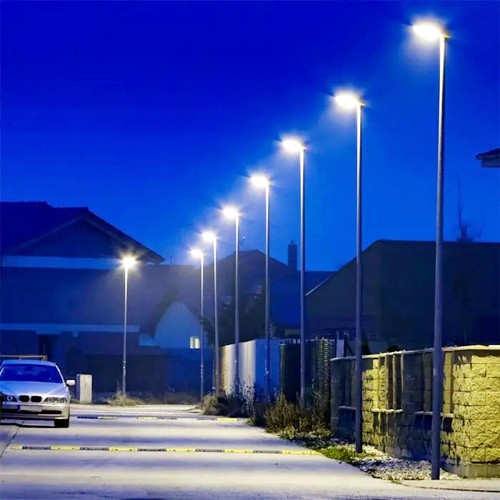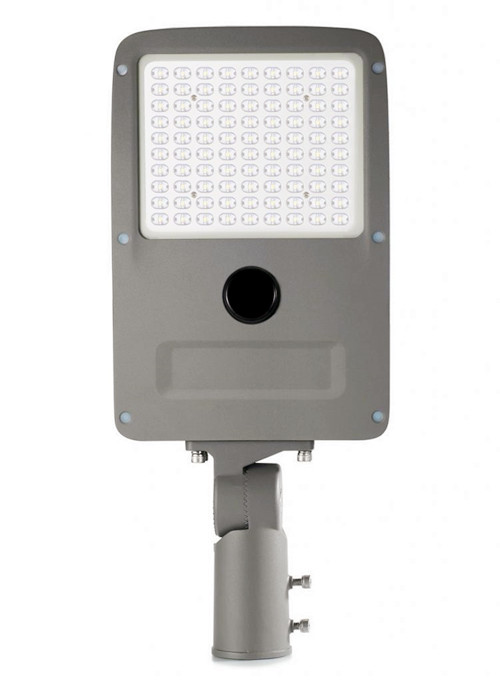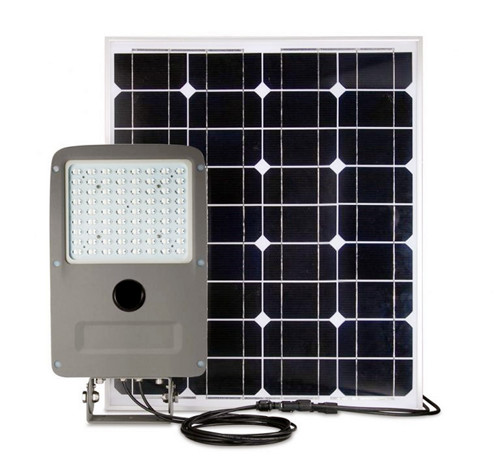
Since the primary objective of road lighting is to ensure safe and comfortable visual conditions for motor vehicle drivers, the evaluation of road lighting quality is approached from the driver's perspective. The main evaluation indicators for road lighting are as follows:
(1) Average Brightness and Average Illumination of the Road Surface
Considering the driver's visual function, the driver's assessment of road conditions heavily relies on the average brightness and average illumination of the road surface. At night, the human eye operates in a mesopic vision state, reducing sensitivity to color differences, and relying mainly on brightness for object discrimination. Therefore, road brightness affects the contrast sensitivity of the driver's vision and the brightness contrast of objects relative to the road.
(2) Uniformity of Road Surface Brightness (or Illumination)
Appropriate uniformity of road surface brightness or illumination is crucial for visual function and comfort. Inadequate uniformity may lead to glare in overly bright areas, causing discomfort, and visual dark areas where obstacles may go unnoticed, posing safety hazards.
(3) Glare Limitation
Glare results from very high brightness or brightness contrast within the visual range, categorized into "disability glare" and "discomfort glare." The former affects normal visual function without causing discomfort, while the latter may cause discomfort without necessarily impacting visual function.
(4) Environmental Ratio (SR)
The Ambient Ratio (SR), also known as the ambient lighting coefficient, assesses the brightness of the road and surrounding environment. SR is defined as the ratio of average illumination between two adjacent light poles on the roadside to the average illumination in the road area starting from the roadside. Generally, SR>0.5 is required. The driver's visual state depends on the average brightness of the road surface, but the surrounding environment's brightness can interfere with general eye adaptation.
(5) High Sleep Induction
Visual induction, or visual guidance, aids drivers and pedestrians in quickly recognizing the road direction within a specified distance and at the maximum allowable speed. On unlit roads at night, visual guidance is limited to the range illuminated by the car's headlights. Proper road lighting, arranged closely along the road direction, enhances visual guidance, contributing to safety and convenience. For roads with curves and intersections, good visual guidance becomes even more critical.
To prevent misguidance, attention should be given to the following when designing road lighting:
* On roads with central medians and separated lanes, light poles should be placed on the central median for easier visual guidance.
* At curves, light poles should be positioned outside the curve to clearly indicate the road direction.
* Using light sources with different color characteristics for lighting on different roads can distinctly indicate different routes, improving guidance.

①.Road classification
|
Specification |
Scope of application |
Category |
Classification basis |
Classification |
|
CIE |
Motor vehicle |
M1-M6 |
Vehicle speed, traffic volume, traffic structure, whether lanes are separated, intersection density, parking, surrounding environment brightness, visual guidance/traffic control |
Weighted calculation method |
|
European Standard (CEN) |
||||
|
North American Standard |
People and bicycles not allowed |
Free roads, highways (A/B) |
Road nature, driving speed |
Definition |
|
People and bicycles allowed |
Main roads, branch roads and local roads (high, medium and low) |
Pedestrian activity, driving speed, road properties |
Definition |
|
|
Chinese standard |
motor vehicle |
Expressway, main road, secondary road and branch road |
The status of roads in the road network, traffic functions and service functions along the routes, etc. |
Definition |
②.Conflict area lighting
CIE also regulates the lighting of so-called conflict areas, where different traffic flows meet on the road, or the geographical conditions of the road change (such as lane reduction), or there is a mixed traffic structure and some other conditions under the same road conditions. Location by mode of transportation (pedestrian, bicycle, etc.).
|
Lighting requirements for pedestrian intersections (current values) [CIE, 2000] |
||
|
|
Lighting standards |
|
|
Area type |
Ehor,av/lx |
Ehor,min/lx |
|
Commercial and industrial areas |
30 |
15 |
|
Residential area |
20 |
6 |
|
Note: The average horizontal illumination value is not allowed to be less than 1.5 times the average illumination on both sides of the intersection on the roadway.
|
||
③. Pedestrians and low-speed traffic
In order to be able to determine the appropriate lighting level based on these factors, CIE provides different weighting values Vw for all these factors. Some of these weight values are listed in Table 9.5. The sum of all weight values Vws determines the number of lighting levels of the traffic environment. The calculation method is P = 6 - Vws
|
CIE lighting levels for pedestrians and low-speed traffic and corresponding values for different lighting standards (existing) [CIE, 2010] |
|||||
|
Lighting level |
Lighting standards |
||||
|
Ehor,av |
Ehor,min |
Ehor,av,max |
Evert,min of facial height |
Esemi-cyl,min for facial height |
|
|
lx |
lx |
lx |
lx |
lx |
|
|
P1 |
15.0 |
3.0 |
22.5 |
5.0 |
3.0 |
|
P3 |
7.5 |
1.5 |
11.2 |
2.5 |
1.5 |
|
P6 |
2.0 |
0.4 |
3.0 |
0.6 |
0.4 |
④.Spectrum of light
Based on the mesopic correction coefficient given in mesopic vision, lower illumination levels are allowed in spectral environments with high S/P ratios. However, it is also mentioned in the same report that the use of low lighting levels is only allowed if the color rendering coefficient R of the light source is greater than 60. If high-pressure sodium lamps with an S/P ratio of 0.6 are used as the reference for uncorrected lamps, then all lamps with a higher S/P ratio (that is, a cooler color temperature) in each level of Pl-P6 will have a lower average Horizontal illumination.
|
The average horizontal illuminance value (existing) after using the intermediate visual correction coefficient in Table 6.3 at each S/P ratio. The correction system is only applicable when Ra≥60. Reference basis: high pressure sodium lamp (S/P ratio is 0.6) |
||||
|
Level |
Ehor,av(lx) |
|||
|
S/P=0.6 |
S/P=1.0 |
S/P=1.4 |
S/P=2.2 |
|
|
lx |
lx |
lx |
lx |
|
|
P1 |
15.0 |
14.4 |
13.8 |
12.8 |
|
P3 |
7.5 |
7.1 |
6.6 |
5.9 |
|
P6 |
2.0 |
1.8 |
1.6 |
1.3 |
⑤.Adaptive lighting
The CIE recommendations clearly state that adaptive lighting has the potential to significantly reduce energy consumption because it can autonomously adapt to temporary changes in the environment, such as traffic, weather, and ambient lighting conditions. If lighting fixtures are designed to be able to adapt (dimm) as truly as possible to large reductions in ambient lighting levels. It is worth noting that in this environment, only an appropriate reduction of the lighting level is allowed but not the uniformity.
The CIE classifies all motor vehicle roads according to their nature, traffic density and the quality of traffic control or separation of the roads. Second, generally speaking, the faster the road speed, the greater the traffic density, the worse the traffic control or separation, the higher the road grade. CIE has made corresponding regulations on lighting indicators.
The CIE (International Commission on Illumination) lighting standards for roads of different grades are outlined as follows:
① Road Lighting Level Definitions:
M1: Highways with dividers and no intersections (e.g., expressways).
M2: Two-way arterial roads, including highways with varying traffic control/separation.
M3: Important urban traffic arteries and regional radiation roads.
M4: Secondary roads, community roads, and roads connected to main roads.
M5: Roads with fewer intersections, sidewalks, and lower traffic density.
② Performance Criteria:
* Average Road Surface Brightness (Lavg):
M1: 2 cd/m²
M2: 1.5 cd/m²
M3: 1 cd/m²
M4: 0.75 cd/m²
M5: 0.5 cd/m²
* Overall Uniformity (Uo): Maintained at 0.4 for all road types.
* Threshold Increment (T1): Commonly set at 10 for M1, M2, and M3, and 15 for M4 and M5.
* Lane Uniformity (UL):
M1, M2, M3: 0.7
M4: Not specified
M5: Not specified
* Ambient Lighting System (SR):
M1, M2, M3: 0.5
M4: Not specified
M5: Not specified
These standards provide detailed criteria for average road surface brightness, uniformity, threshold increment, lane uniformity, and ambient lighting for roads of different grades. They serve as guidelines to ensure appropriate and safe illumination for various road conditions.
For road intersection areas, whether it is motor vehicle drivers, non-motor vehicle drivers, or pedestrians, the illumination of the entire area is very important. At this time, illumination is generally used as a standard requirement index.
As the complexity of traffic at road intersections increases, the likelihood of traffic accidents is correspondingly higher. In order to achieve the purpose of reducing traffic accidents, it is very necessary to improve the lighting standards in road intersection areas. At the same time, in order to prevent glare, the lighting standards for intersection areas also set forth requirements for glare restrictions.
Intersection areas formed by different types of roads have different average illumination requirements.
Here are the lighting standards for different types of road intersection areas:
① The intersection of Main Road and Main Road:
* Average Road Illumination (Eavg): 30 lux (low-block) / 50 lux (high-block)
* Illumination Uniformity (UE): 0.4
* Glare Limit:
* * The light intensity distribution of the lamp in the 80° and 90° altitude angle directions shall not exceed 30 cd/1000 lm.
* * The light intensity distribution of the lamp in the 80° and 90° altitude angle directions shall not exceed 10 cd/1000 lm.
② The intersection of Main Road and Secondary Road:
* Average Road Illumination (Eavg): 20 lux (low-block) / 30 lux (high-block)
* Illumination Uniformity (UE): Not specified
* Glare Limit: Not specified
③ The intersection of Main Road and Branch Road:
* Average Road Illumination (Eavg): 20 lux (low-block) / 30 lux (high-block)
* Illumination Uniformity (UE): Not specified
* Glare Limit: Not specified
④ The intersection of Secondary Trunk Road and Secondary Trunk Road:
* Average Road Illumination (Eavg): 20 lux (low-block) / 30 lux (high-block)
* Illumination Uniformity (UE): Not specified
* Glare Limit: Not specified
⑤ The intersection of Secondary Trunk Road and Branch Road:
* Average Road Illumination (Eavg): 15 lux (low-block) / 20 lux (high-block)
* Illumination Uniformity (UE): Not specified
* Glare Limit: Not specified
⑥ The branch Road Intersection:
Average Road Illumination (Eavg): 15 lux (low-block) / 20 lux (high-block)
* Illumination Uniformity (UE): Not specified
* Glare Limit: Not specified
Note: The table provides two standard values for the average road surface illumination in each type of road intersection area. The left side of "/" represents the low-block illumination value, and the right side represents the high-block illumination value. The standards include specifications for illumination uniformity and glare limits in specific altitude angle directions for certain intersection types.
Sidewalk lighting is mainly to provide a safe lighting environment for pedestrians, so that pedestrians can clearly see the road and surrounding conditions when walking at night to ensure their safety, or to identify obstacles on the road or detect possible approaching dangers. The requirements for uniformity of sidewalk lighting are not strict, but there are requirements for the minimum illumination of the road surface. At the same time, in order to help pedestrians see obstacles on the road clearly, there are also corresponding requirements for vertical illumination.
The lighting standards for different sidewalk types based on pedestrian flow at night are as follows:
① High Traffic Road:
* Business District:
Average road illumination (Eavg): 20 lux
Minimum road surface illumination (Emin): 7.5 lux
Minimum vertical illumination (Emin): 4 lux
* Residential Area:
Average road illumination (Eavg): 10 lux
Minimum road surface illumination (Emin): 3 lux
Minimum vertical illumination (Emin): 2 lux
② Road in Traffic:
* Business District:
Average road illumination (Eavg): 15 lux
Minimum road surface illumination (Emin): 5 lux
Minimum vertical illumination (Emin): 3 lux
* Residential Area:
Average road illumination (Eavg): 7.5 lux
Minimum road surface illumination (Emin): 1.5 lux
Minimum vertical illumination (Emin): 1.5 lux
③ Low Traffic Road:
* Business District:
Average road illumination (Eavg): 10 lux
Minimum road surface illumination (Emin): 3 lux
Minimum vertical illumination (Emin): 2 lux
* Residential Area:
Average road illumination (Eavg): 5 lux
Minimum road surface illumination (Emin): 1 lux
Minimum vertical illumination (Emin): 1 lux
These standards provide guidelines for maintaining appropriate lighting levels on sidewalks in various areas, taking into account the level of pedestrian activity and the characteristics of the surrounding environment.
In addition to meeting the requirements for performance indicators such as illumination, uniformity, glare, and environmental ratio, road lighting must also meet certain energy-saving indicators. Motor vehicle traffic road lighting should use lighting power density (LPD) as the evaluation index of lighting energy saving.
Lighting power density values for motor vehicle traffic roads
① Expressway:
Number of lanes ≥ 6
Lighting Power Density (LPD): 1.05 W/㎡
Corresponding Illuminance: 30 lx
② Main Road:
Number of lanes < 6
LPD: 1.25 W/㎡
Corresponding Illuminance: Not specified
Number of lanes ≥ 6
LPD: 0.70 W/㎡
Corresponding Illuminance: 20 lx
Number of lanes < 6
LPD: 0.85 W/㎡
Corresponding Illuminance: 20 lx
③ Secondary Road:
Number of lanes ≥ 4
LPD: 0.70 W/㎡
Corresponding Illuminance: 15 lx
Number of lanes < 4
LPD: 0.85 W/㎡
Corresponding Illuminance: 15 lx
Number of lanes ≥ 4
LPD: 0.45 W/㎡
Corresponding Illuminance: 10 lx
Number of lanes < 4
LPD: 0.55 W/㎡
Corresponding Illuminance: 10 lx
④ Branch Road:
Number of lanes ≥ 2
LPD: 0.55 W/㎡
Corresponding Illuminance: 10 lx
Number of lanes < 2
LPD: 0.60 W/㎡
Corresponding Illuminance: 10 lx
Number of lanes ≥ 2
LPD: 0.45 W/㎡
Corresponding Illuminance: 8 lx
Number of lanes < 2
LPD: 0.50 W/㎡
Corresponding Illuminance: 8 lx
These values provide standards for the lighting power density of different road levels and the corresponding illuminance levels, ensuring appropriate lighting under various traffic road conditions.
Note:
A. This table is only applicable to high-pressure lamps. When metal halide lamps are used, the corresponding LPD in the table should be multiplied by 1.3.
B. This table is only applicable to conventional road sections with continuous lighting.
C. When the design calculation illumination is higher than the standard value, the LPD value shall not increase accordingly.


In conclusion, adhering to established road lighting standards is essential for creating well-lit environments that prioritize safety and comfort for all road users. From the classification of roads and conflict area lighting to the specific standards for motor vehicles, pedestrians, and energy-saving, these guidelines provide a comprehensive framework for designing effective and efficient street lighting systems. Striking a balance between illumination, uniformity, and energy conservation contributes to the creation of roadways that are not only well-lit but also environmentally sustainable.
Contact: Mr. Otis
Phone: +8615815758133
Tel: +8615815758133
Email: Hello@lederlighting.com
Add: No. 1 Gaoxin West Road,High-tech Zone, Jiangmen, Guangdong, China